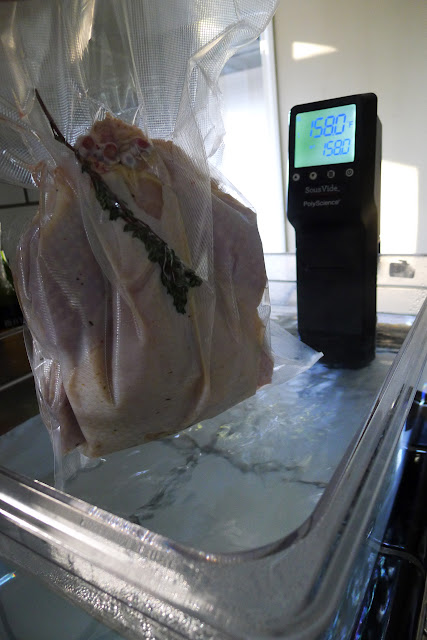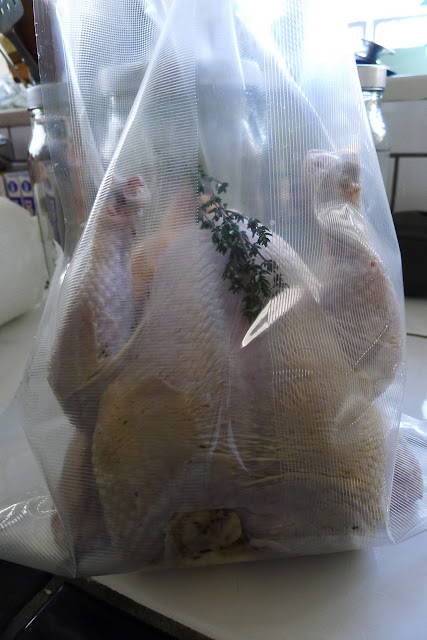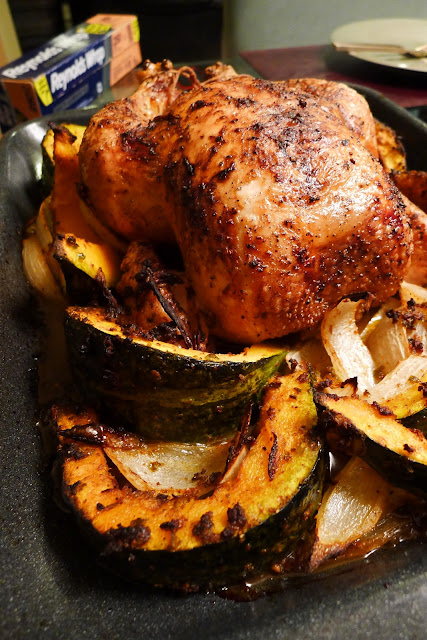No, that's not what my last chicken of the year looked like. But it's how I was convinced to save Judy Rodgers' Zuni Roast Chicken with Bread Salad for last. I was fortunate enough to go to San Francisco last July and eat this famous plate of food with a couple friends at Zuni Cafe. Some might argue that this is the most famous offering of roast chicken in the States. And I can definitely see why. Opinions aside, if you find yourself at Zuni Cafe, their made to order roast chicken is well worth the one-hour wait.
With the taste of tangy bread salad and succulent roast chicken from that summer day still lingering in my mouth, I embarked on my attempt to recreate this dish for my family's last lunch of 2011, and my last chicken for this project.
The recipe starts with a noticeably small chicken. Three pounds, to be exact. Stuffed with your choice of herbs (the recipe recommends thyme, marjoram, rosemary, or sage), salted with a heavy hand, and seasoned generously with freshly ground black pepper. To bring this project full circle, I decided to use two herbs that I love: rosemary and sage. Cover the chicken loosely and refrigerate for at least one full day, and up to three full days.
Next, get a slightly stale open crumb bread. The crumb is the inner part of the bread, and an open crumb is a crumb that is porous and spongy. I used a day-old loaf of French Batard from Whole Foods.
Take off most of the crust, tear the crumb into fairly large chunks, and brush the chunks all over with olive oil. Throw these into an oven on "browning" mode, or simply put these into the oven after you've preheated the oven to 475 degrees for the chicken.
Meanwhile, throw some dried currants into a pool of red wine vinegar and some warm water.
Flip the bread in the oven after about five minutes. After another three to five minutes, the bread should look lightly colored and toasted.
Rip the bread into chunks and toss this in a bowl with olive oil, white wine vinegar, salt, and pepper.
Toss the chicken into the oven, breast side up. In the meantime, stir some scallions and garlic in olive oil over medium until softened. After the chicken has been in the oven for thirty minutes, flip the chicken.
Roast the chicken for another fifteen minutes. Meanwhile, fold the pine nuts, strained currants, garlic, and scallions into the bread crumb.
Flip the chicken one more time so that the chicken is breast side up again and roast for another five to ten minutes. For the last five to ten minutes, throw the bread salad covered with aluminum foil into the oven.
Take out the chicken to rest, but keep the bread salad in the oven for another five minutes.
Reserve the pan drippings to fold into the bread salad after it comes out of the oven.
Drizzle the pan drippings and toss a few handfuls of mixed salad greens into the bread salad. I tossed the greens with some white wine vinegar, olive oil, salt, and pepper before throwing them into the salad to ensure that the salad would have a bright, acidic flavor. I also used the roasting pan itself as the serving platter so that the bread salad would sop up any remaining drippings.
Finally, carve the chicken and nestle the pieces of meat into the bread salad.
The end result was as good as I could've hoped. The dark meat was juicy and, like the white meat, was packed with the potent flavors of rosemary and sage. The most notable part of this recipe was the skin. Insanely crispy. Just as the recipe explains, tying the roast chicken legs, like so many recipes do, would have been a waste of time and would not have maximized the potential crispiness of the skin. The Zuni Cafe version of the roast chicken was still better, but I guess that's why they still handle order upon order of their roast chicken every day.
The recipe starts with a noticeably small chicken. Three pounds, to be exact. Stuffed with your choice of herbs (the recipe recommends thyme, marjoram, rosemary, or sage), salted with a heavy hand, and seasoned generously with freshly ground black pepper. To bring this project full circle, I decided to use two herbs that I love: rosemary and sage. Cover the chicken loosely and refrigerate for at least one full day, and up to three full days.
Next, get a slightly stale open crumb bread. The crumb is the inner part of the bread, and an open crumb is a crumb that is porous and spongy. I used a day-old loaf of French Batard from Whole Foods.
Take off most of the crust, tear the crumb into fairly large chunks, and brush the chunks all over with olive oil. Throw these into an oven on "browning" mode, or simply put these into the oven after you've preheated the oven to 475 degrees for the chicken.
Meanwhile, throw some dried currants into a pool of red wine vinegar and some warm water.
Flip the bread in the oven after about five minutes. After another three to five minutes, the bread should look lightly colored and toasted.
Rip the bread into chunks and toss this in a bowl with olive oil, white wine vinegar, salt, and pepper.
Toss the chicken into the oven, breast side up. In the meantime, stir some scallions and garlic in olive oil over medium until softened. After the chicken has been in the oven for thirty minutes, flip the chicken.
Roast the chicken for another fifteen minutes. Meanwhile, fold the pine nuts, strained currants, garlic, and scallions into the bread crumb.
Flip the chicken one more time so that the chicken is breast side up again and roast for another five to ten minutes. For the last five to ten minutes, throw the bread salad covered with aluminum foil into the oven.
Take out the chicken to rest, but keep the bread salad in the oven for another five minutes.
Reserve the pan drippings to fold into the bread salad after it comes out of the oven.
Drizzle the pan drippings and toss a few handfuls of mixed salad greens into the bread salad. I tossed the greens with some white wine vinegar, olive oil, salt, and pepper before throwing them into the salad to ensure that the salad would have a bright, acidic flavor. I also used the roasting pan itself as the serving platter so that the bread salad would sop up any remaining drippings.
Finally, carve the chicken and nestle the pieces of meat into the bread salad.
The end result was as good as I could've hoped. The dark meat was juicy and, like the white meat, was packed with the potent flavors of rosemary and sage. The most notable part of this recipe was the skin. Insanely crispy. Just as the recipe explains, tying the roast chicken legs, like so many recipes do, would have been a waste of time and would not have maximized the potential crispiness of the skin. The Zuni Cafe version of the roast chicken was still better, but I guess that's why they still handle order upon order of their roast chicken every day.
The bread salad, however, was just as good as I remember. Tangy, acidic, savory, and fluffy, all at the same time. The crispy bits of crumb that opened up to a soft, spongy interior were texturally sublime, and the combination of pine nuts and currants hydrated with red wine vinegar really brought me back to my first bite of this salad in July. All that with a tender bite of the chicken was a perfect way to rein in the penultimate meal of the year.
24 roast chickens? Done and done.
But a project is never complete without a final list of thoughts, lessons, and rankings. And I'd do that now if it weren't for the humungous chicken and bread salad bomb in my stomach (not to mention the turbo delicious handmade pizza my brother made) and the 6:15pm reservations my family has for a much-anticipated six-course dinner at Sotto (after all, what's New Year's Eve without a little bit of a splurge?). Expect that more thoughtful post tomorrow.
For now, I salute you, 2011, for another fulfilling and memorable year, complete with its fair share of ups and downs, garnished with new adventures and discoveries, dusted with disappointments and downfalls, and served with a side of 24 delicious roast chickens.
But a project is never complete without a final list of thoughts, lessons, and rankings. And I'd do that now if it weren't for the humungous chicken and bread salad bomb in my stomach (not to mention the turbo delicious handmade pizza my brother made) and the 6:15pm reservations my family has for a much-anticipated six-course dinner at Sotto (after all, what's New Year's Eve without a little bit of a splurge?). Expect that more thoughtful post tomorrow.
For now, I salute you, 2011, for another fulfilling and memorable year, complete with its fair share of ups and downs, garnished with new adventures and discoveries, dusted with disappointments and downfalls, and served with a side of 24 delicious roast chickens.






